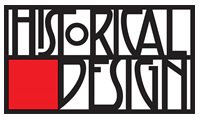Product Description
Gilbert Rohde / Herman Miller American Modernist Clock and Thermometer c.1933


GILBERT ROHDE (1894-1944) USA
HERMAN MILLER CLOCK CO. Zeeland, Mich.
Showroom sample clock and thermometer/barometer c. 1933
Block of seven stacked wood varieties with three brushed chrome bars, chromium-plated rings and original convex glass clock faces
For related Rohde clock designs: American Modern 1925-1940: Design for a New Age, J. Stewart Johnson (New York: Harry Abrams & Am. Federation of Arts, 2000) p. 142-43 The Machine Age in America: 1918-1941, Richard Guy Wilson, Dianne H. Pilgram and Dickran Tashjian, exhibit. Cat. (New York: The Brooklyn Museum and Harry N. Abrams, 1986), vintage Herman Miller catalog.
H: 5 ½” L: 10 ¼” x W: 2 ½”
Gilbert Rohde / Herman Miller American Modernist Clock and Thermometer c.1933
STEINGUTFABRIKEN VELTEN-VORDAMM Werk Velten, Germany
Vase c. 1920
Handpainted and glazed earthenware
Marks: VELTEN-VORDAMM company logo
Similar work illustrated: Keramik und Bauhaus, Klaus Weber et al., exhib. cat. (Berlin: Bauhaus-Archiv, 1989), p. 229, illus. 289.
H: 5” x Dia: 5 1/2″
***Top quality gem blue zircons over 10 carats trade at a minimum price of $200 per carat and go up from there depending on the size of the stone and the quality of the color. Blue zircon, the most popular color, is produced by heat treatment of brown zircon. But not all brown zircon will turn blue when heated; only some zircon has the right physical structure for this to occur. This is why most blue zircon comes from certain sources in Cambodia or Burma. Blue zircon is a reasonably hard gem with a Mohs hardness of about 7 to 7.5. Blue zircon has some unique properties that make it very popular with gemstone aficionados. Not only does zircon have outstanding brilliance, but it also has very strong dispersion or fire, the tendency to split white light into the spectral colors. Zircon also has very pronounced birefringence or double refraction, with a wide variance between the two refractive indices. This can be often be observed with the naked eye when you look down through the table of a cut zircon; you will observe facet doubling that makes the facet edges appear blurred.
